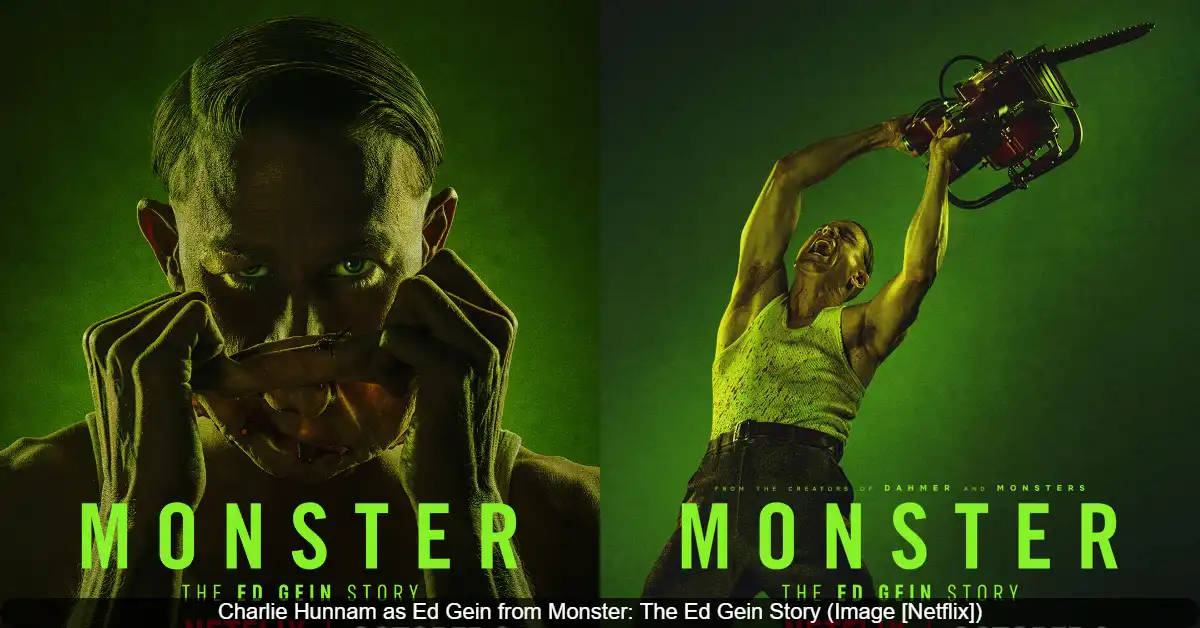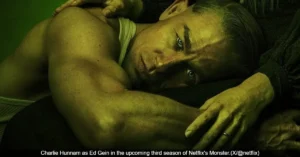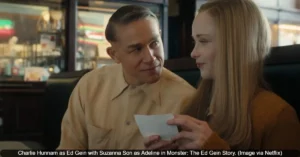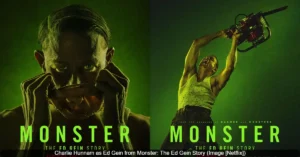The new Netflix series “Monster: The Ed Gein Story“ explores the life of one of America’s most infamous criminals. While the show dramatizes his story, the real Ed Gein spent most of his life after his arrest confined to mental hospitals. His gruesome crimes in the 1950s shocked the nation and later became the unlikely inspiration for some of Hollywood’s most famous horror films.
The third season of Ryan Murphy and Ian Brennan’s “Monster” anthology, which debuted on October 3, 2025, stars Charlie Hunnam as the titular “Butcher of Plainfield.” The series presents a haunting look at Gein’s isolated life on a Wisconsin farm, his disturbing relationship with his mother, and the “house of horrors” discovered by police. The show also examines how his actions forever changed the horror genre, inspiring characters from Norman Bates to Buffalo Bill.
Who Was the Real Ed Gein?
Edward Theodore Gein was born on August 27, 1906, in La Crosse, Wisconsin. He was the second of two sons born to George Gein, an alcoholic who was frequently violent, and Augusta Gein, a fanatically religious woman who dominated his life. Augusta taught her sons that sex was evil and that all women, besides herself, were instruments of the devil. The family lived in isolation on a farm in Plainfield, Wisconsin.
Gein idolized his mother, and her death in 1945 was a devastating blow. He was left completely alone and his mental state deteriorated severely. He boarded up the rooms his mother had used in their farmhouse, preserving them as a shrine, and lived in squalor in a small room next to the kitchen. It was during this period of isolation that he began reading about Nazi atrocities and started his nocturnal visits to local graveyards.
“He was this bizarre guy that lived in his own world, in his own reality, in total isolation with only one other point of contact,” said Charlie Hunnam, who plays Gein in the series. “And so everything in his life was sort of made up, was a work of his own creation.”
The Crimes and the “House of Horrors”
Gein was arrested on November 16, 1957, after the disappearance of a local hardware store owner, Bernice Worden. Her son told police that Gein had been seen with his mother shortly before she vanished. When investigators went to Gein’s farm, they discovered a scene of unimaginable horror.
In a shed, they found Bernice Worden’s body. She had been decapitated, and her body was hung upside down and dressed out “like a deer.” Inside the house, police discovered a collection of macabre artifacts crafted from human body parts. These included:
- A chair and lampshades upholstered with human skin.
- A wastebasket made from human skin.
- Skulls mounted on his bedposts.
- A belt made of human nipples.
- A suit of skin, often described as a “woman suit,” which he used to pretend to be his mother.
- A shoebox containing several human vulvas.
- A human heart in a plastic bag.
- Bowls made from the tops of human skulls.
- Masks made from the skin and hair of women’s faces.
During questioning, Gein also confessed to killing Mary Hogan, a tavern owner who had disappeared in 1954. He admitted to exhuming numerous corpses from graveyards to collect the body parts he used for his creations.
Ed Gein’s Fate: Trial and Institutionalization
Due to the gruesome nature of the discoveries, Gein was initially declared mentally unfit to stand trial. On January 6, 1958, he was committed to the Central State Hospital for the Criminally Insane in Waupun, Wisconsin.
A decade later, in 1968, he was deemed competent to stand trial. He was found guilty of the murder of Bernice Worden, but the judge ruled he was legally insane at the time of the crime. Instead of prison, he was sent back to a mental institution. He was later transferred to the Mendota Mental Health Institute in Madison, Wisconsin.
Gein spent the rest of his life in psychiatric care. By all accounts, he was a model patient. He read books, engaged in occupational therapy, took an interest in ham radio, and was never described as violent or troublesome during his confinement.
Ed Gein died of respiratory failure on July 26, 1984, at the age of 77. He had also been diagnosed with cancer before his death. He was buried in the Plainfield Cemetery, though his gravestone was later stolen and never replaced.
The Legacy in Pop Culture
Despite only being convicted of two murders, Ed Gein’s story had an outsized impact on American popular culture. His crimes directly inspired some of the most influential horror thrillers ever made.
- Psycho (1960): Alfred Hitchcock’s classic film, based on Robert Bloch’s novel, features Norman Bates, a character heavily inspired by Gein’s relationship with his mother and his habit of keeping her belongings.
- The Texas Chain Saw Massacre (1974): The character Leatherface, who wears a mask of human skin, draws directly from Gein’s creation of masks and his “woman suit.”
- The Silence of the Lambs (1991): The villain Jame “Buffalo Bill” Gumb, who skins his female victims to make a suit for himself, is a clear reference to Gein’s crimes.
The new Netflix series makes these connections a central part of its story, featuring characters like Alfred Hitchcock (played by Tom Hollander) and actors from the films he inspired.
“He is probably one of the most influential people of the 20th century, and yet people don’t know that much about him,” said series co-creator Ryan Murphy. “He influenced the Boogeyman and Psycho. Norman Bates was based on him. He influenced The Silence of the Lambs. He influenced The Texas Chain Saw Massacre.”
How the Netflix Series Depicts His End
“Monster: The Ed Gein Story” depicts Gein’s death in a symbolic and fantastical sequence. In the series, as Gein lies dying in the mental institution, he has a vision. Nurses dance around him to the song “Owner of a Lonely Heart” by Yes, and his wheelchair moves down a hallway on its own. He then sees an apparition of his mother, Augusta, at the top of a staircase.
He walks up to meet her, and they have a final conversation where she tells him he “made something of himself” through the movies he inspired. He replies, “The only one I ever wanted to impress was you.” After she says she “couldn’t be more proud,” the scene shifts to show Gein taking his final breaths in his bed. This fictionalized ending provides a dramatic and emotional closure to their complex relationship, which was at the heart of his story.
The real Ed Gein never achieved such peace or recognition. He lived out his days as a psychiatric patient, his name forever tied to the horrifying artifacts found in his quiet Wisconsin farmhouse.
Also Read: Monster: The Ed Gein Story – The True Crime That Inspired Hollywood’s Biggest Thrillers
Credits: Netflix Tudum












